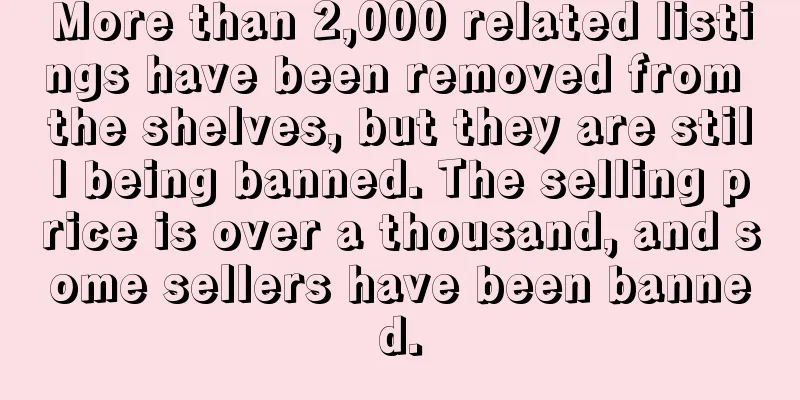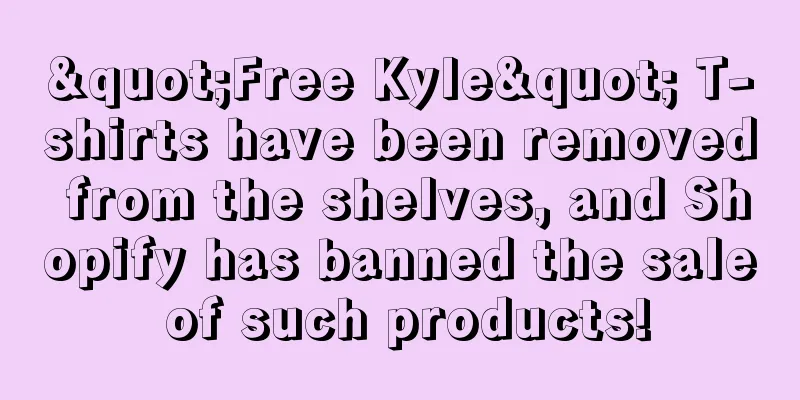A group of sellers were banned for following the lead

|
There are risks in following others to sell, so be careful when doing so.
On the Amazon platform, follow-selling is ubiquitous, especially when a seller has finally made a success of a product, follow-selling will come knocking on their door. Catching up with follow-selling has become an important part of the seller's daily work. Some Amazon sellers even often wake up at 2 or 3 in the middle of the night, not for anything else, just to catch follow-selling, because follow-selling likes to go out at night.
Little do people know that following others in selling products also carries the risk of getting their account blocked.
A group of sellers were banned for following the lead
"The saddest thing about Amazon is not that copycats are like a dog-skin plaster that you can't get rid of, but that when you try to get rid of them, a bunch of sequelae will appear, and eventually your account may be lost..." Recently, Amazon sellers have reported that the operation of chasing copycats has caused trouble:
Don’t follow others easily! Otherwise, your brand will be withdrawn, abused, or shut down. I ended up abusing the brand because of following other people’s lead. Some people used the R mark to drive away follow-up sales and were also found to have abused it. So it’s best not to follow other sellers recently. The brand has been revoked, the account is dead, and the appeal is in progress. …
One of the Amazon operators detailed that after an account failed to catch follow-up sales three times, the brand function disappeared, and the customer service replied that it was brand abuse. Recently, many registered brands have been abused, which is likely caused by the catch-up sales.
There are also sellers who were blocked for following others’ sales. After investigation, it was found that they were complained about for buying out inventory. Currently , PoA is not accepted unless the sellers themselves have evidence to prove that they did not follow others’ sales.
Yien.com learned that among the many sellers who were warned or had their accounts shut down, many of them had one thing in common: they asked service providers to shut down their followers. Why is it risky for service providers to shut down followers? According to an insider, service providers generally have two ways to shut down followers:
The first one is that the service provider uses brands that have participated in the Zero Plan and embeds brand words into the seller’s links to delete the follow-up sales in seconds. This is risky and Amazon is likely to settle the score later. The second method is that the service provider uses his own buyer account to place a large number of pending orders to the follow-selling, locking the follow-selling inventory. This operation also has hidden dangers. The service provider's buying out and driving out the follow-selling operation is also a violation of the policy and will be judged by Amazon to infringe on the rights of other sellers. After the platform detects a large number of pending but unpaid orders, it will impose penalties, ranging from warnings to account suspension.
Regarding the issue that there are risks in service providers catching up with followers, a service provider who catches up with followers stated in detail that many of his peers' catching up with followers' sales operations do not comply with platform regulations. If sellers must find a service provider to catch up with followers' sales, they can make a note not to conduct short buying operations.
In addition, sellers need to be careful when sending warning letters. If the words are too radical or threatening, the counter-complaint against the follow-up sale is likely to be successful. The editor found that many sellers were warned recently because they were judged by the platform to be trying to damage or insult other sellers.
The incident of being blocked for following others’ sales is not a recent occurrence, but has always existed. This requires sellers to pay attention to compliance issues in the process of following others’ sales. Fortunately, many sellers have successfully appealed after being blocked for following others’ sales.
There are many cases of following sales: some people follow sales professionally, and some employees follow sales of company products.
Following sales is undoubtedly a behavior that sellers hate, but in real life, many following sales operations have obviously refreshed the sellers' three views.
Many companies specialize in professional follow-selling, with accounts ranging from dozens to hundreds. The tactic they adopt is to follow the sales of multiple stores in turn. If one store is driven away, they will switch to another store and continue to follow the sales through FBM.
It is not uncommon for acquaintances to follow others in selling. One seller discovered that a large product stored in an overseas warehouse was often followed by others and could not be driven away. After investigation, it was found that the brand had been authorized to the follow-selling store in the background, and this follow-selling store was actually opened by a partner. The partner secretly opened a new store and sold the old link, and still used the inventory in the company's overseas warehouse.
In addition to the phenomenon of partners following sales, there are also many cases of employees following sales of company products. Now many employees have their own stores in private, and many employees secretly open stores and sell the same products as the company. Previously, someone broke the news that two employees of a cross-border e-commerce company gradually became familiar with the company's operations after working for a period of time, and then they had "bad thoughts". They privately applied for Amazon accounts, followed the company's products, and illegally occupied the company's warehouse products and shipped them directly from the company's warehouse. At the same time, they also contacted the company's suppliers behind the company's back and took goods from the suppliers. All of the above account applications and logins, follow-sales records, sales data and other operations were performed on the company's computers ... There are many similar cases. Many companies directly called the police on the spot after discovering them, and the employees may face the risk of losing money or even going to jail!
Summary of methods to catch and follow sales
Follow-selling is rampant. In addition to seeking help from service providers, sellers can also do it themselves. But the question is, how can sellers successfully get rid of follow-selling?
Weibo blogger "Amazonxiafanmao" said that brand-registered sellers can apply for removal by themselves in the background, file complaints in the front desk, or test buy (Test Buy refers to placing an order to purchase the product that the seller plans to report, and after receiving the goods, confirming that the product is indeed infringing, and then reporting it. Remember to keep the order number, which is required when reporting) to report counterfeits; non-brand sellers can also test buy and report second-hand goods. Although it takes a long time, the effect is very good.
In addition, sellers are required to provide valid Test buy information when reporting the following three types of infringements: Trademark product packaging-offer level (the product or its packaging has my trademark), Copyright product packaging-offer level (the product or its packaging belongs to or contains copyrighted content), and Design right/patent-offer level ( potential violation of design patent) .
However, there are some minefields for sellers when using test buys. For example, using the buyer's account associated with the seller's account to place an order may result in the buyer's account being blocked, which may cause the seller's account to be reviewed. If a buyer's account that rarely logs in places orders frequently, the platform may also determine that it is suspected of fake orders and account theft and block it.
In the specific complaint process, brand sellers need to indicate that they are the brand owner and provide brand information. They need to provide evidence of the difference between the copied product and their own, prove that the other party is imitating or selling fakes, and the potential harm it will cause to the platform and buyers. Non-brand sellers can file a complaint and provide evidence that the other party is passing off old products as new, or that the products are not the same as the ones in the pictures, and the adverse effects it will have on the platform and buyers.
Do not mention multiple types of infringement in one report. For example, if you choose trademark infringement, do not describe others misusing your copyrighted images in the problem description. Do not report two trademark numbers at the same time . If you do, Amazon will only consider the first trademark number. If you want to report infringement of multiple different trademarks, you need to submit separate reports.
What methods do you have to catch copycat sellers? Feel free to leave a message to discuss. |
<<: The king of volume enters Amazon: the profit is almost 0!
>>: 400 yuan per order! Intermediaries are recruiting part-time workers to register Amazon stores
Recommend
Brazil's Olist prepares for IPO after raising $23 million
Existing backer Redpoint Events, which first inve...
Hot sales indicator! TiK ToK's top Amazon search list is released
If you ask what is the most popular sales softwar...
92% of Americans want it! This type of product continues to be popular
Although life is gradually returning to normal, m...
What is Trustpilot? Trustpilot Review, Features
Founded in 2007, Trustpilot is a global consumer ...
Strict review before PD causes a large number of Amazon sellers to lose performance
Prime Day is approaching, and another wave of str...
What is Netflix Movie Rental? Netflix Movie Rental Review, Features
Netflix is an American online video rental servi...
What is Siheng Network? Siheng Network Review, Features
Founded in 2006, Siheng Network is a technology c...
Temu is in controversy again over "quality", buyers: cheap is more important
Following shein, Sweden has welcomed another plat...
The latest news: Amazon’s peak season delivery fees for 2024 are here!
Today, Amazon notified sellers that it will imple...
Tsunami warning in effect, Southern California piers closed
Recently, the Tonga volcano eruption has attracte...
What is Guangsuda Logistics? Guangsuda Logistics Review, Features
Guangsuda Logistics (Shenzhen Guangsuda Logistics...
The sellers are suffering due to the frequent problems of lost items and difficulty in capital turnover!
There are endless problems such as "My item ...
Sharing the cake! Kuaishou opens e-commerce functions to users in the US market
Recently, the domestic short video platform Kuais...
A big cross-border retailer offers 100 million yuan in equity to encourage employees
The cross-border e-commerce industry has been ver...
What is Leyu Cross-border? Leyu Cross-border Review, Features
Leyu Cross-border (Shenzhen Leyu Supply Chain Man...









